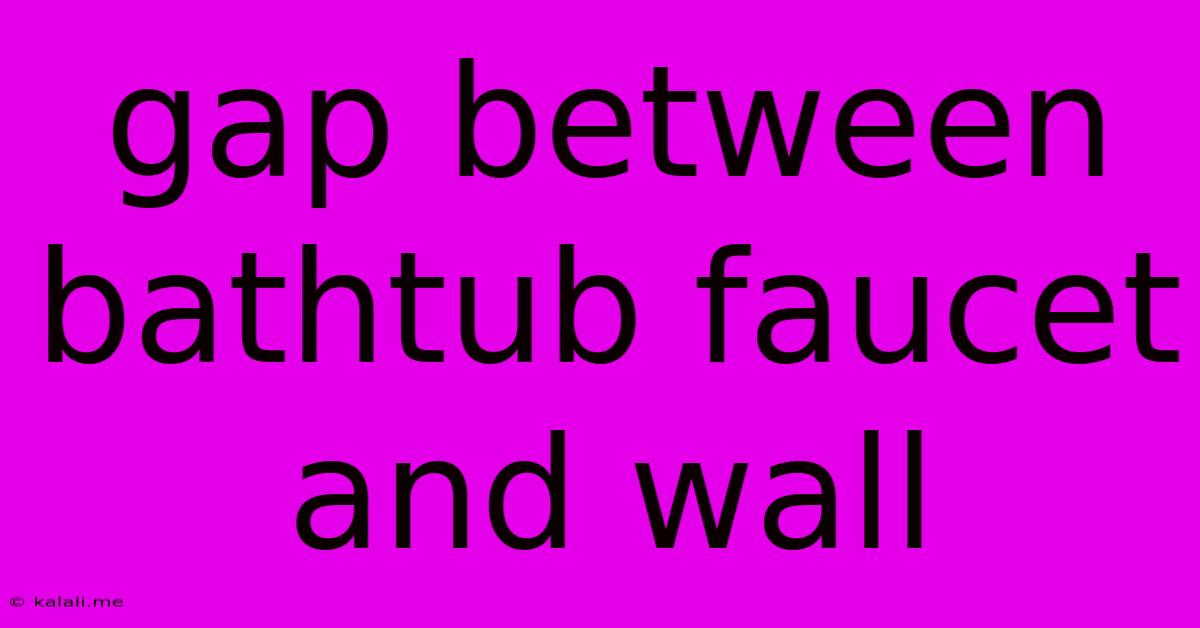Gap Between Bathtub Faucet And Wall
Kalali
May 28, 2025 · 3 min read

Table of Contents
That Annoying Gap: Fixing the Space Between Your Bathtub Faucet and Wall
A small gap between your bathtub faucet and the wall might seem insignificant, but it can be a major source of frustration. This gap not only looks unsightly, potentially detracting from your bathroom's aesthetic appeal, but it can also lead to water damage, mold growth, and even structural issues over time. This article will explore the common causes of this gap, and offer practical solutions for fixing it, ensuring a beautiful and functional bathroom.
Understanding the Gap: Why is it there?
The gap between your bathtub faucet and the wall is often a result of improper installation. Several factors contribute to this problem:
- Inaccurate Measurements: Incorrect measurements during installation are a leading cause. If the faucet isn't positioned precisely, a gap is inevitable.
- Uneven Wall Surface: Uneven or damaged wall surfaces can prevent the faucet from sitting flush against the wall. This is particularly problematic with older homes or those with less-than-perfect wall finishes.
- Improper Caulking: Inadequate caulking or the use of the wrong type of caulk can leave gaps that widen over time. Caulk is crucial for creating a watertight seal.
- Faulty Faucet Base: Sometimes, the problem lies with the faucet itself. A warped or damaged base plate will prevent proper installation and create a gap.
- Settling of the House: In some cases, subtle settling of the house can create a gap that wasn't present initially. This is less common but worth considering.
How to Fix the Gap: A Step-by-Step Guide
Fixing the gap requires careful attention to detail and the right tools. Here's a breakdown of the process:
1. Assessment and Preparation:
- Identify the Cause: Carefully examine the gap to determine the underlying cause. Is it due to improper installation, a damaged base plate, or something else?
- Gather Supplies: You'll need a utility knife, a caulking gun, silicone caulk (preferably paintable, mildew-resistant bathroom caulk), a damp cloth, and possibly a chisel or putty knife (depending on the severity of the issue). Consider using a backer rod for a more durable seal.
2. Cleaning the Area:
- Remove Old Caulk: Use a utility knife to carefully remove any existing caulk from the gap. Clean the area thoroughly with a damp cloth to remove any debris, ensuring a clean surface for new caulk.
3. Applying the Caulk:
- Insert Backer Rod (Optional): For larger gaps, a backer rod helps reduce the amount of caulk needed and creates a more durable seal. Insert the backer rod into the gap before applying caulk.
- Apply Caulk: Load your caulking gun with silicone caulk. Apply a smooth, continuous bead of caulk along the gap, pressing firmly to ensure good adhesion.
- Smooth the Caulk: Use a damp finger or a caulking tool to smooth the caulk, creating a neat, professional finish.
4. Finishing Touches:
- Allow to Dry: Allow the caulk to dry completely according to the manufacturer's instructions. This usually takes 24-48 hours.
- Clean Up: Remove any excess caulk with a damp cloth.
Addressing More Serious Issues:
If the gap is significant or caused by a faulty faucet base or uneven wall, you may need to consider more drastic measures. This could involve:
- Re-installing the Faucet: If the faucet base is damaged, it might need replacing, requiring complete faucet re-installation.
- Wall Repair: Significant wall imperfections might require patching or repair before the faucet can be properly installed. This may involve the expertise of a professional.
Prevention is Key:
To prevent this issue in the future, ensure that your faucet is installed correctly by a qualified professional. Accurate measurements, proper preparation, and the use of high-quality materials are crucial for a long-lasting, leak-free installation.
By following these steps, you can effectively fix the gap between your bathtub faucet and wall, restoring the aesthetic appeal of your bathroom and preventing potential water damage. Remember, if you're uncomfortable tackling this repair yourself, it's always best to consult a professional plumber.
Latest Posts
Latest Posts
-
Bug That Looks Like A Spider
May 30, 2025
-
How Old To Get A Hotel Room
May 30, 2025
-
3 Black Wires 3 White Wires Outlet
May 30, 2025
-
Do The Quotations Go After The Period
May 30, 2025
-
The Final Battle Will Not Be Fought
May 30, 2025
Related Post
Thank you for visiting our website which covers about Gap Between Bathtub Faucet And Wall . We hope the information provided has been useful to you. Feel free to contact us if you have any questions or need further assistance. See you next time and don't miss to bookmark.